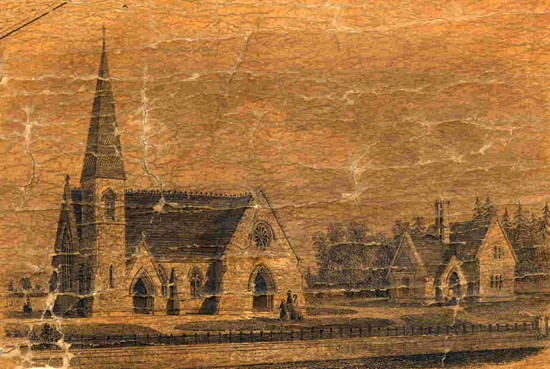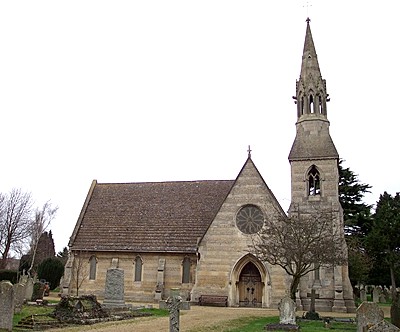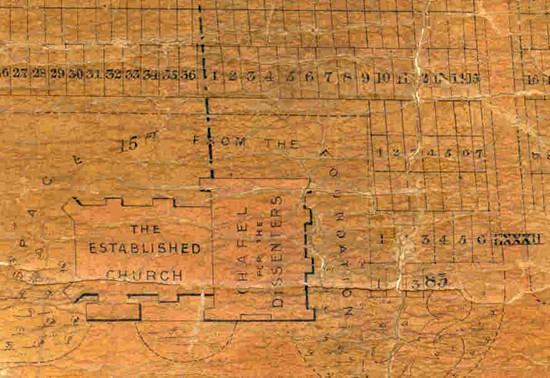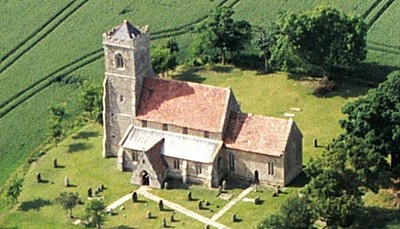|
The architect of the cemetery chapel
The cemetery chapel was designed by Edward Browning in 1854 after he had drawn up plans for a similar building at Stamford. He was the son of Bryan Browning (1773-1856) who was in practice at Stamford during the 19th century and was responsible for many famous buildings in the area including the Town Hall at Bourne, the Baptist Chapel, the workhouse [later St Peter's Hospital] and the House of Correction at Folkingham. Edward (1816-1882) also trained in the profession, becoming equally successful, based at his father's offices at No 16 Broad Street, Stamford, where he soon had a large practice and a reputation as an ecclesiastical architect, working on many new and restored churches and chapels in the region, including Bourne Abbey, extensive alterations to the parish church at Uffington and the small Victorian apsidal chapel at St Andrew's Church, Sempringham. There are around thirty listed buildings attributed to him or associated with him, including the stone bridge erected over the River Welland at Stamford in 1849 (Grade 11) while his ecclesiastical commissions included the design of several rectories, including the Gothic rectory at Lowick, Northamptonshire (Grade 11 listed, 1855-56) which famously inspired its literary guests. Edward and his father both worked on alterations to Apethorpe Hall, Northamptonshire in the 1850s. He also designed the National School in Eastgate, Bourne [now demolished], in 1857, and was chosen to design the Ostler memorial fountain in 1860 dedicated to a local worthy that once stood in Bourne market place but because of traffic problems was moved in 1962 to the town cemetery where it can still be seen. The Burial Act of 1853 authorised the provision of publicly-funded cemeteries across the country and this ushered in a boom in their construction by burial boards run by parish vestries. Lincolnshire was one of the first counties to join the race for cemetery provision following the Act and competitions for chapel designs were held at Boston, Grimsby, Holbeach and Louth in 1854, Lincoln in 1855 and Grantham in 1856. At Bourne, the burial board invited Edward Browning to submit plans for the two chapels in one building and a lodge house and these were accepted by members at their meeting on Wednesday 15th February 1854, his architect's fee to be 5% of the total cost. The land, almost four acres of meadow [3 acres 2 roods and 7 perches] on the west side of South Road, had already been purchased from local landowner Philip Duncombe Pauncefort Duncombe for £420 and Browning's plans were subsequently chosen from several submissions that had been invited by the board. At a meeting on Thursday 30th March, members agreed to spend £1,600 on establishing the cemetery although it was later realised that a further £400 would be needed to meet the final costs bringing the total bill to £2,000. This included the purchase of land, building the chapels and lodge house, fees and enfranchisement, drainage, levelling and roads, legal expenses for the conveyancing of the land and a brick or stone wall required by the vendor, and was equivalent to a penny rate per annum spread over 10 years although some of the cost was expected to be defrayed by voluntary subscriptions from the wealthier people of the town. After prolonged discussions and argument with members of the Vestry Meeting [forerunner of our local council system], the board agreed that two acres of the land be set aside for consecration and use by the Church of England, including the approaches, gardens, chapels, lodge and frontage, and the remainder to be left unconsecrated for the dissenters or non-conformists and others required to use it. The Vestry Meeting also gave the burial board the necessary sanction to borrow the money required to finance the project. Browning's designs were subsequently
approved by the Bishop of Lincoln, the Rt Rev John Jackson, and the building work was put out to tender, four
being received, from Messrs Ruddall and Thompson of Peterborough (£975),
Messrs Swann and Bradshaw of Stamford (£940), Mr J T Jeffs of Stamford
(£857) and Mr Moses Peal of Stamford (£845), the latter being the
successful bid. Mr Peal's tender for building the protecting wall around
the cemetery at a cost of 3s. 9d. per superficial yard was also accepted. As can be seen from the sketch above, Browning originally included a bell tower, some 70 feet high, as he did for the design of the cemetery chapel at Stamford where it was intended to house a fine-toned bell weighing ¾ cwt, originally one of the bells from St Mary's Church but not used for more than two centuries. Although the same bell tower was envisaged for the Bourne chapel, the idea never materialised. Costs were rising and it would appear that once the estimates became known by the burial board, plans for the bell tower were scrapped. It is also interesting to note that the cost of the Stamford chapels and lodge house was £996 which compares favourably with the Bourne scheme which was £151 less but did not include a tower. The similarities of the Bourne chapel with that at Stamford also reflect the hand of Edward Browning because both buildings have the same circular window, a doorway with a pointed arch and a door with decorative hinges although the Stamford chapel has retained its tower. An understanding of the financial climate of the time is necessary to appreciate the need for such economy. The establishment of a cemetery was forced on parishes throughout England by the Burial Board Act of 1854 which authorised the setting up of public burial boards outside London to cope with the demand for grave space because many churchyards had become full and money for the project had to be paid for by a levy in rates upon parishioners by the burial board. The board eventually reached the final figure of £2,000, having cut out any unnecessary expenditure to avoid an undue burden being placed upon ratepayers which, as now, would not be a popular move, by economising with the chapel building and so the tower and spire were removed from the plans and never actually built because they are not referred to in a description of the chapel carried by the Stamford Mercury when the consecration service was held on Saturday 26th May 1855. In addition, the earliest known photograph of the chapel taken around 1900 shows no tower or traces of one that might had been built and later demolished for some reason.
At its monthly meeting on 7th February 1855, the board appointed a gatekeeper for the cemetery, Charles Christopher, who would live at the lodge rent free but without salary, his only duty being to ensure that the grounds were not damaged by intruders. Work was finally finished by Saturday 26th May 1855 when the new cemetery was consecrated by the Bishop of Lincoln and the following Friday, 1st June 1855, all other burial grounds in Bourne attached to churches were closed by Act of Parliament.
The Bourne Burial Board existed from 1854 until 1899 when its duties were taken over by Bourne Urban District Council but this too ceased to exist on 12th March 1974 when it was swallowed up under a re-organisation of local government by the newly constituted South Kesteven District Council and a mass of its records and paperwork were destroyed, dumped in a skip outside the offices in North Street and carted off to the rubbish tip. The only records of the burial board known to have survived are the documents described above which are now preserved at the county archives in Lincoln. Edward Browning became an Associate of the Royal Institute of British Architects and was active in the community as a justice of the peace and Mayor of Stamford from 1862-63. He retired in 1881 and moved with his family to Dudlow House in Upper Tooting, London, where he died on April 14th the following year, aged 65. The chapel was listed Grade II by the Department of Culture, Media and Sport (DCMS) on 4th April 2007 on the advice of English Heritage. Their assessment was made as the result of an application for spot listing from local historian Rex Needle after Bourne Town Council had announced its intention to demolish the building. The ruling means that the chapel cannot now be pulled down without special permission and the council will be required to carry out restoration work and bring it back into use, perhaps in another role.
REVISED JULY 2008 See also The Grade II listing of the cemetery chapel Why the cemetery chapel should be preserved
Go to: Main Index Villages Index
|



